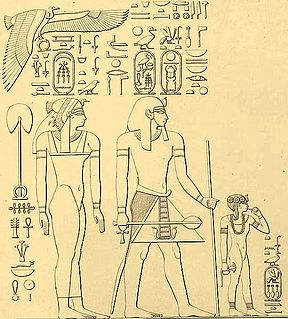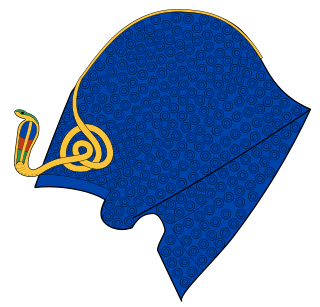
Amenhotep III, also known as Amenhotep the Magnificent, was the ninth pharaoh of the Eighteenth Dynasty. According to different authors, he ruled Egypt from June 1386 to 1349 BC, or from June 1388 BC to December 1351 BC/1350 BC, after his father Thutmose IV died. Amenhotep III was Thutmose's son by a minor wife, Mutemwiya.

Ahmose was an Ancient Egyptian queen in the Eighteenth Dynasty. She was the Great Royal Wife of the dynasty's third pharaoh, Thutmose I, and the mother of the queen and pharaoh Hatshepsut. Her name means "Born of the Moon".

Ineni was an Ancient Egyptian architect and government official of the 18th Dynasty, responsible for major construction projects under the pharaohs Amenhotep I, Thutmose I, Thutmose II and the joint reigns of Hatshepsut and Thutmose III. He had many titles, including Superintendent of the Granaries, Superintendent of the Royal Buildings, Superintendent of the Workmen in the Karnak Treasuries, etc.

Deir el-Bahari or Dayr al-Bahri is a complex of mortuary temples and tombs located on the west bank of the Nile, opposite the city of Luxor, Egypt. This is a part of the Theban Necropolis.

God's Wife of Amun was the highest-ranking priestess of the Amun cult, an important religious institution in ancient Egypt. The cult was centered in Thebes in Upper Egypt during the Twenty-fifth and Twenty-sixth dynasties. The office had political importance as well as religious, since the two were closely related in ancient Egypt.
Amenemhat or Amenemhet is an Ancient Egyptian name meaning "Amun is in front". Amenemhat was the name of a number of kings, princes and administration officials throughout ancient Egyptian history.

Great Royal Wife, or alternatively, Chief King's Wife, is the term that was used to refer to the principal wife of the pharaoh of Ancient Egypt, who served many official functions.

The khepresh was an ancient Egyptian royal headdress. It is also known as the blue crown or war crown. New Kingdom pharaohs are often depicted wearing it in battle, but it was also frequently worn in ceremonies. It used to be called a war crown by many, but modern historians refrain from defining it thus.
Menkheperre was a prince of the Eighteenth Dynasty of Egypt, one of two known sons of Pharaoh Thutmose III and his Great Royal Wife Merytre-Hatshepsut. His name is the throne name of his father and means “Eternal are the manifestations of Re”.
Sennefer or Senneferi was an ancient Egyptian official during the 18th Dynasty.
The Eighteenth Dynasty of Egypt is classified as the first dynasty of the New Kingdom of Egypt, the era in which ancient Egypt achieved the peak of its power. The Eighteenth Dynasty spanned the period from 1549/1550 to 1292 BC. This dynasty is also known as the Thutmosid Dynasty for the four pharaohs named Thutmose.
Articles related to ancient Egypt include:

Women in ancient Egypt had some special rights other women did not have in other comparable societies. They could own property and were legally at court, equal to men. However, Ancient Egypt was a society dominated by men. Women could not have important positions in administration and were also excluded from ruling the country although there are some significant exceptions. Women at the royal court gained their position by the relationship to a male king.
















